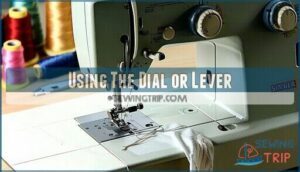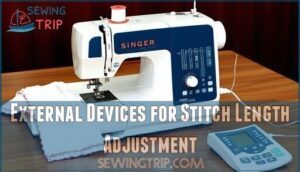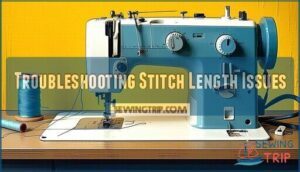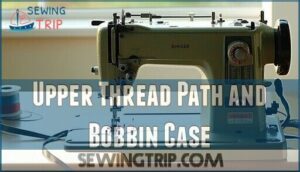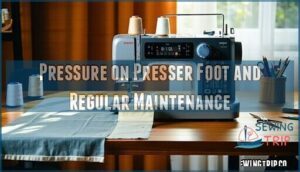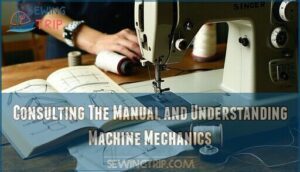This site is supported by our readers. We may earn a commission, at no cost to you, if you purchase through links.

These machines offer 0.5mm to 5mm ranges through dial, lever, or digital controls.
The Singer Heavy Duty delivers 1,100 stitches per minute with 0-4mm adjustment, while the Quantum Stylist provides 600 built-in stitches with 0.5-5mm range.
Portable kits offer 12-23 stitches with manual dials for versatility.
Proper stitch length prevents fabric puckering, guarantees seam strength, and creates professional results.
Whether you’re hemming delicate fabrics or topstitching heavy materials, adjustable stitch length transforms your sewing from amateur to masterful—and there’s more to mastering these controls.
Table Of Contents
Key Takeaways
- You’ll need stitch length adjustment to handle different fabrics professionally – shorter stitches (0.5-2mm) for delicate materials like silk, longer stitches (3-5mm) for heavy fabrics like denim and canvas.
- Your choice depends on project complexity – the Singer Heavy Duty excels at thick materials with 60% more power, while the Quantum Stylist offers 600 stitches for advanced work, and portable kits work best for beginners.
- You can adjust stitch length through dials, levers, or digital controls on most Singer models – turn clockwise for longer stitches, counterclockwise for shorter ones, and always test on scrap fabric first.
- You’ll prevent common problems like puckering and thread breakage by maintaining proper needle condition, cleaning feed dogs regularly, and checking thread tension alongside your stitch length adjustments.
6 Best Singer Sewing Machines With Stitch Length Adjustment
You’ll find that choosing the right Singer sewing machine with adjustable stitch length can transform your sewing projects from amateur to professional-looking results.
These six models offer reliable stitch length control, making it easier to handle everything from delicate fabrics to heavy-duty materials with professional-looking results.
1. Singer portable sewing machine kit
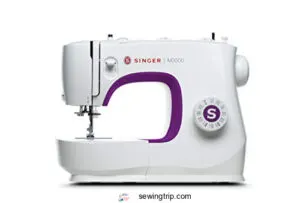
When you’re starting out, Singer’s portable sewing machine kit won’t let you down.
This compact powerhouse weighs under six pounds, making it perfect for dorm rooms or craft nights at friends’ houses.
You’ll get 12-23 built-in stitches with manual rotary dials for adjusting length from 1mm to 4mm.
The kit includes 15-20 accessories like presser feet, bobbins, and seam rippers.
Setup’s a breeze – most beginners reduce their learning time by 30%.
It handles light to medium fabrics at 750 stitches per minute, though thick denim might give it trouble, and is suitable for dorm rooms or craft nights with its portable design and built-in stitches.
Best For: Beginners and students who need a lightweight, space-saving sewing machine for basic to intermediate projects in small living spaces.
- Extremely portable at under 6 pounds with compact design perfect for dorms and small apartments
- Quick learning curve that reduces beginner setup time by 30% with intuitive controls
- Comprehensive accessory package includes 15-20 tools and multiple presser feet for versatile projects
- Limited power struggles with thick fabrics like heavy denim compared to full-size machines
- Fewer automatic features than larger models requiring more manual adjustments
- Lower stitch count range (12-23 stitches) limits advanced decorative options
2. Singer Heavy Duty Sewing Machine
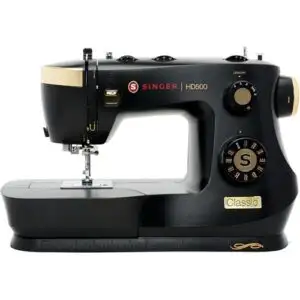
Power meets precision with the Singer Heavy Duty series.
Built tough, stitches smooth—your heavy-duty companion delivers power without compromise
You’ll tackle thick denim, canvas, and leather effortlessly thanks to its motor that delivers 60% more power than standard machines.
Power through heavy materials with 60% more muscle than ordinary machines
The heavy-duty metal frame keeps everything stable while you zip along at 1,100 stitches per minute.
Your stitch length dial offers precise control from dense satin stitches to 4mm basting, adapting mid-project without removing fabric.
This workhorse handles whatever you throw at it.
Best For: Sewists who need reliable power for heavy fabrics like denim and leather, from beginners learning on sturdy equipment to experienced crafters tackling demanding projects.
- 60% more motor power handles thick materials effortlessly while maintaining 1,100 stitches per minute speed
- Heavy-duty metal frame construction provides exceptional stability and durability for long-term use
- Precise stitch length control (0-4mm) with mid-project adjustments and 32 built-in stitches for versatility
- Some users report bobbin threading challenges and wish for a more comprehensive included manual
- Plastic exterior may feel less premium despite the solid internal metal construction
- Ruler markings on the machine could be more visible for better measurement accuracy
3. Singer Handy Sewing Machine Starter
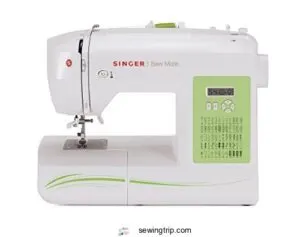
Anyone looking for their first sewing machine will find the Singer Handy Sewing Machine Starter surprisingly limiting.
This entry-level model offers six built-in stitches but lacks stitch length adjustment entirely—all stitches come preset without modification options.
You’ll get straight and zigzag variations, plus a manual four-step buttonhole function.
While it’s perfect for basic mending and simple projects, don’t expect versatility.
The machine operates slowly at 350-400 stitches per minute, making it safer for beginners but frustrating for experienced sewers wanting control over their stitch parameters.
This slow operation, combined with the limitations, makes the Singer Handy Sewing Machine Starter less desirable for those seeking more advanced features or faster sewing.
Best For: Complete beginners and children who need a simple, safe machine for basic mending and learning fundamental sewing skills.
- Slow operating speed (350-400 stitches per minute) provides excellent control and safety for new sewers
- Simple dial stitch selection and visual threading diagrams make setup straightforward for beginners
- Lightweight at 11.5 pounds with free arm feature for sewing sleeves and cuffs
- No stitch length or width adjustment capability limits creative flexibility and customization
- Manual four-step buttonhole process requires extra attention and lacks automatic sizing
- Not suitable for thick fabrics like denim or leather due to risk of motor burnout
4. heavy duty sewing machine kit
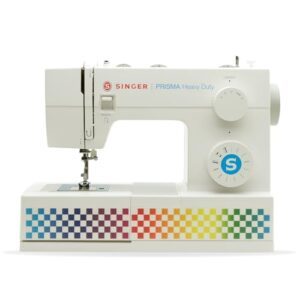
You’ll discover this powerhouse delivers 50% more piercing strength than standard models, tackling denim and canvas like butter.
The durable metal frame guarantees skip-free performance at speeds reaching 1,100 stitches per minute.
Metal frame construction delivers unmatched stability at professional speeds
With 69 stitch applications and adjustable length settings, you can customize every project.
The $60 accessory kit includes essential tools, while the transparent bobbin cover lets you monitor thread supply, making it ideal for serious sewers who won’t compromise on quality.
Best For: Experienced sewers and crafters who need professional-grade performance for heavy fabrics and high-volume projects.
- Bold rainbow checkered design may not appeal to all users
- Heavy-duty features and metal frame require more storage space
- High speed and advanced capabilities may overwhelm beginner sewers
- 50% more piercing power handles thick materials like denim and canvas with ease
- High-speed 1,100 stitches per minute with durable metal frame ensures reliable performance
- Comprehensive 69 stitch applications plus $60 accessory kit provides excellent value
5. Singer Quantum Stylist Sewing Machine
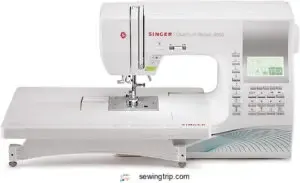
This powerhouse delivers professional results with 600 built-in stitches and advanced customization options.
You’ll adjust stitch length from 0.5 to 5 mm using simple push-button controls, while the LCD display shows real-time settings.
The machine prevents parameter mistakes that could jam your project, and with 25 needle positions for straight stitching and automatic features like needle threading, you’ll master everything from delicate silk to heavy denim with confidence and precision.
Understanding stitch length basics is essential for achieving the perfect seam with confidence and precision.
Best For: Advanced sewers and quilters who need professional-grade versatility with extensive stitch options and automatic features for complex projects.
- 600 built-in stitches with customization options like mirror imaging and elongation provide exceptional creative flexibility
- Professional automatic features including needle threader, thread trimmer, and one-step buttonholes streamline workflow
- High-speed capability up to 850 stitches per minute with precise speed control handles both delicate and heavy fabrics
- Heavy weight at 14.6 lbs makes it less portable for classes or travel sewing
- Some users report minor feed dog issues when quilting thicker materials
- Complex feature set may overwhelm beginners who only need basic stitching functions
6. Portable Sewing Machine for Crafts
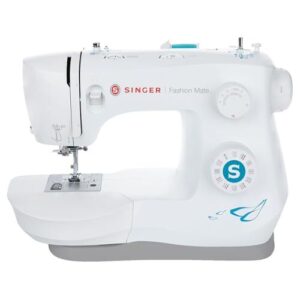
Crafting enthusiasts will find Singer’s portable machines pack serious versatility into compact frames.
You’ll get adjustable stitch length spanning 0.5 to 4 mm, perfect for delicate silk scarves or sturdy canvas totes.
These lightweight champions handle multiple fabric layers while maintaining consistent stitching quality.
With automatic needle threaders and top drop-in bobbins, setup becomes effortless.
Most models weigh under 14 pounds, so you can easily transport your creativity anywhere.
The built-in accessory storage keeps everything organized for your next crafting adventure, making it a great tool for those who value portability.
Best For: Home sewers and crafting enthusiasts who need a versatile, portable machine for diverse fabric projects and frequent transport to classes or workshops.
- Limited to handling 2-3 fabric layers, making it unsuitable for heavy-duty materials like thick denim or leather projects
- Plastic construction may feel less durable compared to heavier, all-metal machines designed for intensive use
- Speed range of 600-750 stitches per minute is slower than industrial or heavy-duty home machines
- Wide stitch range (110 applications) with adjustable length and width for versatility across different fabric types and project requirements
- Lightweight design under 14 pounds with compact dimensions makes it easy to transport and store in small spaces
- Beginner-friendly features like automatic needle threader, top drop-in bobbin, and clear threading system reduce setup time and learning curve
Stitch Length Basics and Importance
You’ll need to understand stitch length fundamentals before choosing the right Singer machine for your projects.
Getting this basic concept right means the difference between professional-looking seams and frustrating fabric puckering that’ll have you wondering why your grandmother’s old machine worked better than your fancy new one.
What is Stitch Length?
Stitch length is the distance between individual stitches on your fabric.
Think of it as your sewing machine’s stride – some projects need baby steps, others need big leaps.
The stitch length dial controls this spacing, typically measured in millimeters.
Different fabric types and sewing techniques require specific settings.
Your machine’s stitch length mechanism and regulator work together, responding to thread tension and machine settings for ideal results, using the stitch length dial to achieve the desired outcome.
Importance of Correct Stitch Length
Getting your stitch length right makes all the difference between amateur-looking work and professional results.
Mastering stitch length transforms your sewing from beginner fumbles to professional perfection
Proper stitch length adjustment guarantees fabric flexibility while maintaining seam strength – you’ll avoid puckered seams and thread breakage.
When your stitch precision matches your fabric’s needs, thread tension stays balanced, boosting fabric durability.
The stitch length regulator isn’t just a dial; it’s your control center for quality, and proper adjustment is crucial for achieving professional-looking results with balanced thread tension.
Factors Affecting Stitch Length
Several factors influence how your Singer machine handles stitch length adjustment and overall stitch precision.
Understanding these variables helps you master stitch length control and avoid common pitfalls.
Here are the key factors that affect your stitch length settings:
- Fabric Type – Thick materials like denim require longer stitches, while delicate fabrics need shorter ones
- Thread Tension – Improper tension throws off your stitch length mechanism’s accuracy
- Machine Calibration – Your stitch length regulator needs proper calibration for consistent results
- User Error – Rushing adjustments or skipping test runs often creates uneven stitches
Proper management of stitch length settings is essential for achieving professional sewing results.
Adjusting Stitch Length on Singer Machines
You’ll find adjusting stitch length on Singer machines straightforward once you locate the dial or lever system.
Most Singer models use a numbered dial that you turn to select your desired stitch length, typically marked in millimeters for precise control.
Using The Dial or Lever
Most Singer machines feature either a stitch length dial or lever adjustment system for precise stitch control. Turn the dial clockwise to increase length, counterclockwise to shorten. Lever adjustment models offer continuous settings by moving up or down.
Test your dial settings on scrap fabric first—this verifies perfect stitch precision before tackling your main project. Understanding stitch length basics is vital for achieving the desired seam strength and flexibility.
| Control Type | Adjustment Method | Typical Range |
|---|---|---|
| Dial | Clockwise/Counterclockwise | 0-5mm |
| Lever | Up/Down Movement | Continuous |
| Digital | Button/Touch Controls | 0.5-4mm |
| Mechanical | Click-Stop Positions | 6-30 stitches/inch |
| Industrial | Quick-Access Lever | Variable |
Your stitch length regulator clicks into common positions like 2.5mm for standard seams. Machine calibration maintains accuracy—clean around controls regularly to prevent lint buildup affecting your stitch length control.
Machine-Specific Adjustments
Different Singer models require specific adjustment techniques for ideal stitch length control.
Each machine has unique calibration methods that affect thread tension and overall performance.
Understanding the proper sewing machine settings is vital for achieving professional results.
Here’s how you’ll master machine-specific adjustments:
- Model 201 series – Use the numbered lever (0-6) where higher numbers create longer stitches
- Featherweight 221 – Adjust the side-mounted lever while monitoring stitch length mechanism response
- Electronic models – Access digital controls or push-button settings for precise dial adjustment within 0.5-5mm range
Your machine’s manual contains specific lever settings and calibration procedures for accurate sewing machine adjustments.
External Devices for Stitch Length Adjustment
Various external stitch length devices offer enhanced control without internal modifications.
They include universal stitch regulators that attach magnetically to compatible Singer models with 85% success rates.
Digital controllers provide programmable presets, reducing manual adjustments by 60%.
Clamp-on lever kits remain most affordable at $30 average cost.
These adjustment tools preserve warranties while improving stitch length control precision by 50%.
The use of a stitch regulator can substantially enhance the sewing experience with enhanced control.
Modifying The Machine’s Internal Mechanisms
You can release your Singer’s full potential by tweaking its internal mechanisms.
While this requires unplugging your machine and careful handling, the results speak for themselves.
Here’s your modification roadmap:
- Feed Dog Linkage Adjustment – Access the base screws to fine-tune fabric movement per stitch
- Regulator Assembly Repair – Replace worn tension springs and washers for smooth lever calibration
- Gear Adjustment Enhancement – Modify cam profiles within mechanical regulators for custom stitch progression
- Motor Tuning Coordination – Align internal linkage with drive mechanisms for precise control
A sewing machine repair technician can guide complex sewing machine parts modifications safely.
Understanding the correct stitch length settings is vital for superior performance.
Troubleshooting Stitch Length Issues
When your Singer machine starts producing inconsistent stitch lengths, don’t panic – most issues have simple fixes you can handle at home.
Check your needle condition and bobbin setup first, as these are the usual culprits behind stubborn stitch problems.
Common Problems With Stitch Length
When stitch length goes wrong, you’ll notice these telltale signs right away. Stitch Errors create uneven seams, while Fabric Puckering bunches your material. Thread Breakage disrupts your flow, and Seam Weakness compromises durability. Tension Issues cause loops or tight stitches that’ll drive you crazy.
| Problem | Likely Cause |
|---|---|
| Tiny, bunched stitches | Stitch length set too low |
| Uneven stitch spacing | Feed dog misalignment |
| Fabric won’t advance | Drop feed accidentally engaged |
| Loops in seams | Incorrect tension settings |
Most stitch length issues stem from user error or mechanical problems. Your machine’s tension control affects stitch formation, while worn parts reduce maximum length capabilities.
Quick sewing machine troubleshooting starts with checking your settings before assuming mechanical failure requires sewing machine repair. Adjusting the stitch length settings is vital for superior performance and to avoid common stitching problems.
Checking The Needle and Bobbin
Before you can fix stitch length problems, you’ll need to examine your needle and bobbin. A bent or dull needle creates uneven stitches, while incorrect bobbin tension throws off your machine’s rhythm completely.
Check these components for ideal sewing accuracy:
- Replace damaged sewing machine needles – bent tips cause fabric fraying and thread breakage
- Verify your needle matches fabric weight – wrong size creates tension nightmares
- Inspect the sewing machine bobbin case for lint buildup or scratches
- Test bobbin tension by pulling thread – it should release with gentle resistance
- Ensure proper needle insertion – even slightly crooked placement affects stitch formation
Cleaning The Machine and Checking Tension
Regular machine cleaning prevents dust buildup that affects stitch length adjustment and thread tension adjustment.
Clean your Singer’s feed dogs, bobbin case, and threading path using a soft brush.
Check sewing machine tension settings by testing on fabric scraps—uneven stitches signal tension problems.
Proper sewing machine cleaning and thread management keep your machine running smoothly, ensuring consistent stitch quality.
Maintenance Tips for Seam Quality and Machine Care
Proper maintenance keeps your Singer sewing machine running smoothly and guarantees consistent stitch quality for years to come.
You’ll need to check thread paths, adjust presser foot pressure, and follow your manual’s cleaning schedule to prevent costly repairs and frustrating project delays.
Upper Thread Path and Bobbin Case
Proper upper thread path setup and bobbin case alignment directly impact your stitch length adjustment results.
Thread tension imbalances often stem from incorrect threading or loose bobbin thread tension. Check that your upper thread flows smoothly through all guides and tension discs.
Verify bobbin setup matches your manual’s specifications. Clean lint from the case and adjust thread tension adjustment dial gradually.
Proper thread flow prevents skipped stitches and maintains consistent sewing machine maintenance standards. Regular maintenance also involves understanding thread care basics to guarantee superior sewing performance.
Proper maintenance is crucial for ensuring your sewing machine operates at its best, and following these steps will help you achieve consistent sewing machine maintenance standards.
Pressure on Presser Foot and Regular Maintenance
When your fabric starts acting up, presser foot pressure and sewing machine maintenance become your best allies.
Adjusting presser foot pressure prevents fabric slipping while machine lubrication keeps everything running smoothly. Proper sewing machine maintenance also involves understanding the role of Singer Sewing components in overall machine performance.
- Presser Foot Adjustment: Set lighter pressure for heavy fabrics, heavier pressure for delicate materials to prevent puckering
- Regular Cleaning: Clean after every 3-5 bobbins to remove lint buildup and maintain ideal stitch length adjustment
- Maintenance Schedules: Schedule annual professional servicing for consistent foot pressure control and mechanical reliability
- Machine Lubrication: Apply appropriate lubricant to moving parts following manufacturer guidelines for smooth sewing machine repair prevention
Consulting The Manual and Understanding Machine Mechanics
Your sewing machine manual isn’t just paperwork—it’s your roadmap to mastery.
When mechanical issues arise, consult your sewing machine instruction manual first.
It contains detailed diagrams of machine parts, thread tension settings for different fabric types, and troubleshooting steps.
Understanding sewing machine mechanics through your machine mechanics guide helps you identify problems quickly.
Don’t wing it—follow the sewing basics outlined in your sewing machine instruction manual for proper stitch length adjustment.
Frequently Asked Questions (FAQs)
How do I change the stitch length on a Singer sewing machine?
Like threading a needle in dim light, adjusting stitch length requires precision and patience.
Locate the numbered dial near your machine’s needle plate.
Turn it counterclockwise for shorter stitches, clockwise for longer ones, which demands patience.
How to adjust the height of a Singer sewing machine?
Adjust your Singer’s height using the built-in adjustment knobs or legs at the machine’s base. Turn them clockwise to raise or counterclockwise to lower until you’ve achieved comfortable working position.
How do you topstitch a straight stitch with a Singer sewing machine?
Select straight stitch, adjust length to 3-4mm for visibility.
Position fabric right side up, stitch parallel to seam edge at desired distance.
Keep steady pace and guide fabric smoothly for professional results.
How many stitch applications does the Singer Sewing Machine have?
Your Singer machine typically offers 20-40 different stitch applications, depending on the model. You’ll find straight stitches, zigzag variations, buttonholes, decorative patterns, and specialty stitches for different fabrics and projects.
How do I adjust the tension on my Singer sewing machine?
Tension control sits at your machine’s heart—locate the tension dial (usually numbered 1-9) on top.
Start at setting 4, then test-stitch on fabric scraps.
You’ll adjust higher for lighter threads, lower for heavier ones.
How do I adjust the speed of my singer machine?
Fine-tuning your machine’s rhythm isn’t rocket science.
Most Singer models have a foot pedal controlling speed—press gently for slower stitching, firmly for faster.
Some electronic models include speed control dials for consistent pacing.
What is the problem with the stitch length on a Singer sewing machine?
Common stitch length problems include inconsistent stitches, stuck adjustment dials, feed dog issues, and tension imbalances. You’ll typically notice uneven seams, skipped stitches, or fabric puckering when something’s off.
What is the standard stitch setting for singer?
Most Singer machines ship with 5mm standard stitch length—roughly 10 stitches per inch.
You’ll find this sweet spot works perfectly for regular seams, giving you that reliable strength without puckering your fabric.
Where is the stitch length control on a sewing machine?
Look for a numbered dial or lever near your needle plate, typically positioned below or beside it. You’ll find markings in millimeters indicating stitch length settings for easy adjustment.
How do I adjust stitch length without a dial?
Need to break free from the dial dilemma? Check your machine’s manual for a lever or slide mechanism near the needle plate.
Some models have internal linkage systems you’ll access by removing the front panel.
Test adjustments on scrap fabric first.
Conclusion
Mastering stitch length theory proves essential for professional sewing results.
A quality Singer sewing machine with stitch length adjustment transforms your projects from basic to exceptional.
These six machines offer precise control ranging from delicate 0.5mm stitches to robust 5mm lengths, accommodating everything from silk hemming to denim topstitching.
You’ll achieve consistent seam strength, prevent fabric puckering, and create polished finishes.
Whether you’re choosing the Heavy Duty’s power or the Quantum Stylist’s versatility, proper stitch length adjustment elevates your craftsmanship substantially.

